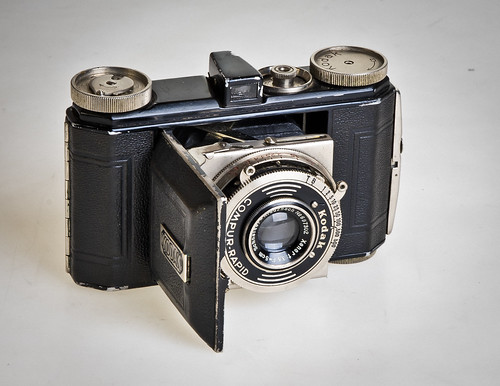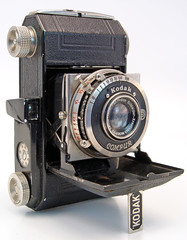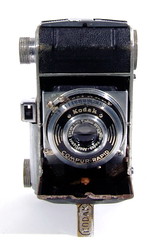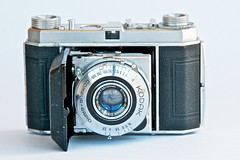Kodak Retina I
The Kodak Retina I is a vertical spring folder for 135 format. It was designed by Dr. August Nagel who was the founder of the August Nagel Camera Works; he sold his firm to Eastman Kodak in 1932, and its name changed to Kodak AG.
The original Kodak Retina (type 117) is a historically significant camera, because Kodak introduced the now ubiquitous daylight-loading 135 cartridge for this camera (earlier 35mm cameras required 35mm cine film to be manually spooled into proprietary cassettes). The design of the Retina borrowed significantly from the 127-film Vollenda which had been manufactured by Nagel before its takeover by Kodak.

|
| model 118 image by SBA73 (Image rights) |
The Retina I cameras differ from the Retina II and III models in that they use scale focusing, rather than using a rangefinder. The later Retina models are among the archetypal rangefinder cameras, and Kodak introduced the Retinette name for the corresponding viewfinder cameras.
The eventual triumph of the 135 format owed much to the acceptance of the Retina as a compact, precision 35mm camera, as well as to the success of lower-priced alternatives such as those manufactured by Argus.
The following is a list of Retina I cameras produced from 1934 to 1950. Production stopped during the WW2, but interestingly the numbers produced almost evenly split between before and after the war[1].
| Type | Timeframe | Numbers produced |
|---|---|---|
| 117 | 1934-1935 | 29,299 |
| 118 | 1935-1936 | 46,898 |
| 119[2] | 1936-1938 | 39,000 |
| 126 | 1936-1938 | 31,900 |
| 141[2] | 1937-1939 | 27,000 |
| 143 | 1937-1939 | 15,000 |
| 148[2] | 1939-1940 | 15,000 |
| 149 | 1939-1940 | 15,000 |
| 167 | 1940-1941 ? | 2,000 |
| Kodak AG stopped camera production in the summer of 1941. Plant was requisitioned by German government to make time-fuses. First camera parts for post-war production manufactured in July 1945. | ||
| 010 | 11/1945-06/1949 | 126,000 |
| 013 | 08/1949-12/1950 | 116,000 |
| Total Production: | > 460,000 | |
| Various Kodak Retina I models | ||||||||
|
|
| ||||||
Notes
- ↑ Retina production over the years on KniPPsen
- ↑ 2.0 2.1 2.2 Between 1936 and '40, the Retina was always available in two forms; 'Modell I schwarz', with black-painted body trim, and 'Modell I verchromt', with chrome-plated trim. Thus the 119 and 126 are otherwise identical, and were available concurrently, as were the 141 and 143, and the 148 and 149: see the pictures.


